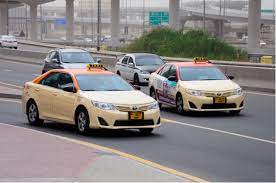Dubai taxi fares have seen a series of fluctuations in recent months, leaving passengers wondering just how much their next ride will set them back. The city’s reliance on fuel, coupled with rising global oil prices, has had a direct impact on the cost of getting around by taxi.

Dubai Taxi: The Price Per Kilometer
As of August 2024, the base fare for a taxi in Dubai remains at Dhs12, but the cost per kilometer has risen to Dhs2.14 when using a S’hail with RTA or booking through Careem. This marks an increase from the previous rate of Dhs2.21 per kilometer.
However, it’s essential to remember that Dubai taxi fares are dynamic and can change based on several factors, including:
- Time of Day: Peak hours typically result in higher fares.
- Distance: Longer journeys will naturally cost more.
- Traffic Conditions: Congestion can lead to increased waiting times and higher fares.
The Impact of Fuel Prices
The correlation between petrol prices and Dubai taxi fares is evident. As fuel costs rise, so too do taxi fares. Dubai has experienced fluctuating petrol prices throughout the year, with increases in June 2024 contributing to the latest adjustment in taxi rates.
While the increase in taxi fares might be frustrating for passengers, it’s important to recognize that taxi drivers are also facing higher operational costs. The rising fuel prices directly impact their earnings, making it a balancing act for authorities to ensure fair pricing for both passengers and drivers.
Calculating Your Fare
To estimate the cost of your taxi ride, you can use the following formula:
- Total Fare = Base Fare + (Distance x Per Kilometer Rate) + Waiting Time Charges
Most ride-hailing apps provide an estimated fare before you confirm your booking, making it easier to budget for your journey.
A Growing Industry
Despite the fluctuating fares, Dubai’s taxi industry continues to thrive. In the first three months of 2024, the Dubai Taxi Company (DTC) reported a 15% increase in revenue compared to the previous year. This growth can be attributed to several factors, including:
- Increased Ridership: More people are using taxis for their daily commutes and leisure activities.
- Longer Trips: People are traveling longer distances within the city.
- Expanded Fleet: The DTC has doubled its fleet at Dubai International Airport, catering to the growing number of passengers.
The Future of Taxi Fares
While it’s difficult to predict future trends, it’s likely that taxi fares will continue to fluctuate in response to global oil prices. However, Dubai’s commitment to sustainable transportation and the growing popularity of public transport options may influence the overall demand for taxis in the long term.
As a passenger, staying informed about fare changes and utilizing ride-hailing apps with fare estimates can help you plan your journeys and manage your budget effectively.

